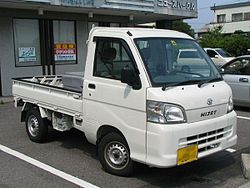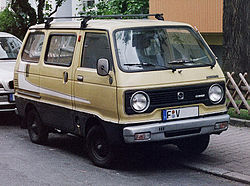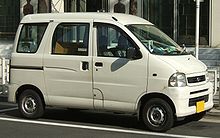- Daihatsu Hijet
-
Daihatsu Hijet 
The ninth generation Daihatsu Hijet truckManufacturer Daihatsu Also called Daihatsu Atrai
Daihatsu Extol
Piaggio Porter
Subaru Dais Wagon
Toyota SparkyProduction 1960–present Class Kei truck Body style Van
Pickup truckPlatform Mid-engined, rear-wheel drive / four-wheel drive The Daihatsu Hijet is a microvan and pickup truck produced by the Japanese automaker Daihatsu. Despite the similarities between the Hijet name and Toyota's naming scheme for its trucks and vans (Hiace and Hilux), the name "Hijet" has been in use for Daihatsu's Kei trucks and vans since 1960, over two decades before Toyota took control. "Hijet", when transliterated into Japanese, is very similar to "Midget", one of Daihatsu's other mini-trucks. The Hijet competes in Japan with the Honda Acty, Subaru Sambar, Mitsubishi Minicab, and the Suzuki Carry.
Contents
History
The first Hijet received a 360 cc two-stroke engine, as was dictated by the kei car laws of the time. The Hijet's development has long followed the evolution of Japan's kei regulations, with an increase to 550 cc in 1976 and then 660 cc for 1990. Exterior dimensions have also increased somewhat, from 3 x 1.3 m originally to 3.4 x 1,475 m today. Export versions have usually been somewhat larger as bigger bumpers and sometimes wider bodies are fitted.
The band Diehatzu Hijets, of similar spelling, pay homage to the vehicle.
Fourth generation (S60)
Daihatsu Hijet Wide 55 
Manufacturer Daihatsu Production 1977-1981 Class kei truck Body style Van
Pickup truckLayout mid-engine, rear-wheel drive Platform S60 Wheelbase 1,780 mm (70 in) Length 3,195 mm (126 in) Width 1,395 mm (55 in) Height 1,625 mm (64 in) In March 1977, production of the truck version of the fourth generation began. Called the Hijet Wide 55, to draw attention to its wider body and bigger 550 cc engine, this was the first Hijet to reach export markets in any serious numbers. The 547 cc AB20 was a four-stroke, water-cooled two-cylinder unit. Power output is 28 PS (21 kW) at 5,500 rpm, while max torque is 4.0 kg·m (39 N·m; 29 lb·ft) at 3,500 rpm. The only transmission installed is a four-speed manual with a floor-mounted shifter.
The engine is mid-mounted just behind the front axle, and access is gained by simply lifting the front seats. Chassis code is S60, with the succeeding letter "P" signifying a simple pickup bed with one opening flap; "T" for the three-way dropside pickup; and "V" for the vans.[1]
Three months after the introduction of the pickups (in June 1977), a glassed van with sliding doors and also a "panel van" version were released. The panel van was simply a truck with a box mounted on the rear; this version was not exported.[1] For export, a van version without windows or rear seats was preferred. A low floor dropside bed was added in December 1977, and a minor facelift took place in September 1978. The changes were limited to different colored bumpers and headlight surrounds, and a changed metal grille insert featuring a larger "D" logo. All versions were available in either Standard or Super DeLuxe trims, but in March 1979 a comparatively luxurious "Custom EX" version of the light van was added.[1]
In September of 1979, the Hijet Wide 55 underwent a more thorough facelift: A new front clip with a single-piece grille was the most obvious change, while inside there was a new more sculpted dash as well as more comfortable seats which were now adjustable. Production continued until replaced by the fifth generation Hijet in 1981.
Ninth generation (S200)
When the ninth generation Hijet was introduced in 1999, a divergence between the truck and van versions (Cargo) occurred, with the vans now being of a front-engined "semicab" design rather than the mid-engined cabover design retained for the truck. A tenth generation of the Hijet Cargo has since appeared, but the ninth generation of the truck remains in production. A similar divergence took place in the Suzuki Carry lineup, necessitated by new crash protection legislations enacted for passenger cars. Since the Hijet Cargo also forms the basis for the passenger use Atrai, it too now has a front-mounted engine.
Tenth generation (S320)
The tenth generation is only available in van form, with the trucks remaining the ninth generation cabover model. In Japan, the passenger car version of the Hijet is known as the Daihatsu Atrai, which is also powered by a 660 cc Turbo engine producing 64 bhp (48 kW). Available engines for 2006 include the DVVT equipped 660 cc EF-VE, making 39 kW (52 hp) at 7,000 rpm and 63 N·m (46 lb·ft) of torque at 4,000 rpm, and the 660 cc EF-SE, making 33 kW (44 hp) at 5,900 rpm and 57 N·m (42 lb·ft) of torque at 3,600 rpm. The base model is mid-engined with rear-wheel drive, but four-wheel drive versions are also available.
Variants
Piaggio Porter, based on the fourth generation Hijet
There are also versions of the Hijet sold outside Japan, available with 1.0 and 1.3-litre engines. These are no longer considered kei cars, as they are wider and longer than allowed by these narrowly defined regulations. The Hijet Maxx/Hijet Jumbo is a pick-up truck or chasis cab which can be set up for other uses such as a moving stall. The Daihatsu Zebra (also known as the Daihatsu Citivan, Daihatsu Devan, and Daihatsu Zebra Espass) is a van version of the Hijet Maxx. The Perodua Rusa is a rebadged Zebra sold by Daihatsu's Malaysian partner, Perodua. In the Japanese market, there was also a larger version of the ninth generation Hijet, sold as the Hijet Gran Cargo. This car has been exported as the Extol as well.
The Piaggio Porter is a licenced version manufactured in Italy since 1992 (originally as the "Innocenti Porter"), available also with diesel, LPG or electric motors. Originally equipped with a 1.0 petrol or a 1.2 litre diesel, more recent cars receive a 1,269 cc petrol/LPG engine or a 1,371 cc diesel.[2] The 1.3 offers 65 PS (48 kW) in either configuration while the 1.4 diesel only manages 38 PS (28 kW).[3] All of these Porter variants are based on the facelifted sixth generation of the Hijet (S82) which has its front wheel located below the front door and a mid-mounted engine. The S82 Hijet also provided the basis for Kia's Towner.
In 2007, Daihatsu Indonesia launched the new Daihatsu Gran Max which is based on the newest Hijet ("semicab", front wheels located forward of the door). It is powered by 1,300 and 1,500 cc engines and is both wider and longer than the kei car based Hijet. It replaces the previous Daihatsu Zebra of similar size. The Gran Max is available in minivan and pick-up bodystyles and since February 2008 it is imported to Japan where it is sold as the Toyota LiteAce (S402).
Hybrid Hijet
In 2002, Daihatsu debuted the Hijet Cargo Hybrid concept, a hybrid van, in Japan using a 660 cc engine. The car is based on the existing non-hybrid Hijet Cargo. Daihatsu calls it a mild hybrid design. Its design (called Daihatsu Mild Hybrid System or DMHS based on Toyota hybrid technology) is quite different from many existing hybrid design where as the gas and electric powered components assembled as one unit. The electric motor sits between the gasoline powered engine and the transmission unit. The car is 30% more fuel efficient than its gas-powered counterpart.
The hybrid minicars (called FEV - Ultra Fuel Economy - and Atrai Hybrid-IV) made its debut in 2002 as a concept minicar.[4] Its production was announced in October 2004 but as of May 2006 had not been released.
See also
- Daihatsu
- Kei trucks
References
- ^ a b c Parts Catalog: Daihatsu Hijet Wide 55 S60, Daihatsu Motors, 1981, p. 1
- ^ "Far East Auto Literature - Japanese Kei Minivans". Xs4all.nl. http://www.xs4all.nl/~mjs/cabover.html. Retrieved 2011-07-31.
- ^ Calin, Mihaela (2005-09-29), "O noua provocare pe piata auto constanteana" (in Romanian), Romania Libera, http://www.romanialibera.ro/actualitate/fapt-divers/o-noua-provocare-pe-piata-auto-constanteana-75629.html
- ^ "Daihatsu Motor Co., Ltd. - Annual Report 2002" (PDF). http://www.daihatsu.com/ir/library/pdf/annual02.pdf. Retrieved 2011-07-31.
External links
Current vehicles: Atrai/Hijet · Be-go/Terios · Boon/Sirion · Coo/Materia · Copen · Esse · Mira/Cuore/Charade · Mira Cocoa · Move · Tanto · Tanto Exe · XeniaPast vehicles: Altis · Applause · Bee · Ceria · Charade · Charmant · Compagno · Cuore · Consorte · Domino · Leeza/Leeza Spyder · Fellow Max · Max · Midget · Mira Gino/Trevis · Naked · Opti · Gran Move/Pyzar · Rocky/Feroza/Sportrak · Rugger/Rocky/Fourtrak · Sirion/Storia · Sonica · Taft/Scat · Taruna · Valera · YRVConcept Cars: ai · Basket · Copen (1999) · Costa · D-Bone · D-Compact X-Over · Deca Deca · Extol · EZ-U · FFC · HVS · Micros-3R · OFC-1 · SK-Tourer · SP-4 · U4B · UFE2 · UFE-III · X-021 · Mudmaster CRace Cars: P3 · P5Categories:- Daihatsu vehicles
- Microvans
- Pickup trucks
- Hybrid minivans
- Kei trucks
Wikimedia Foundation. 2010.




